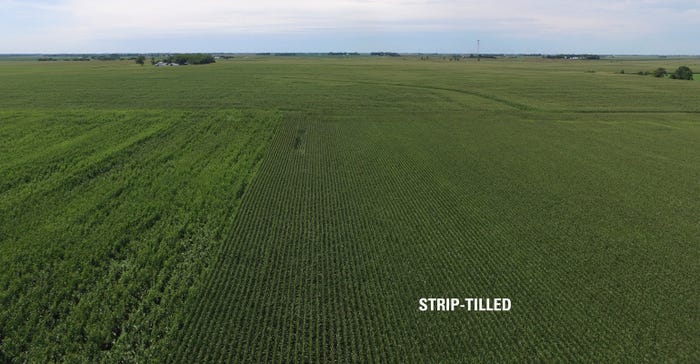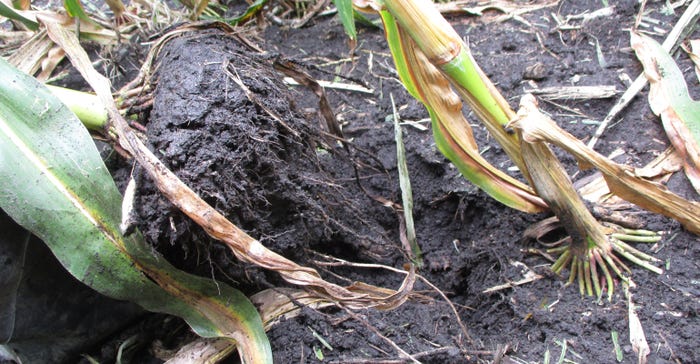August 18, 2020

A major topic of conversation has been field conditions in western Minnesota after recent storms. No one likes talking about storm damage to crops. However, I think this is a great opportunity to talk about a very important aspect of crop management, as there is a good explanation as to why the patterns in the down corn are seen.
We know that a multitude of things conspired to make the corn act as it did, yet I also think there is a “best fit” explanation to what we see.
Here are some of the things that obviously affected our corn:
Row orientation. The rows planted in a north-south orientation were definitely hit harder. This is probably due to the proximity of neighboring plants in east-west planted rows to tolerate the westerly wind.
Hybrid. Yes, many folks have commented that hybrid makes a difference, and this is very true. I see enough split planter fields around to verify this, but it doesn't explain similar patterns in fields planted all with one hybrid. And, yes, I see where conventional corn has stood better than traited corn and vice-versa.
Planting date and maturity. This is much harder to assess but it's intuitive to think that it had an influence.
Crop rotation. Corn on corn is generally harder hit. I’ve had discussion, too, with farmers about the influence of our extensive 2019 prevented plant acres, but I haven't found anything there yet.
Variable wind. Nature is never uniform. I heard reports of over 100 mph winds in some areas.
So why the patterns that we are seeing?
I took photos with a drone shortly after a storm in early August and share them here. They offer a great opportunity to learn about the impacts of soil and crop management.
One photo shows the corn standing better in the wheel tracks of the planter and of the primary tillage pass this spring (angle rows). The best explanation for this is that the soil was tilled too loose and the wheel tracks put some more firmness to the soil so that the roots had something to hold onto.
 BETTER ANCHOR: This drone photo of a strip-tilled cornfield taken a couple days after a heavy storm shows corn still standing. The strip that the corn was planted in is higher in structure and water infiltration, and it has other favorable soil characteristics that allowed for the corn and soil environment to resist the wind, according to Gatchell.
BETTER ANCHOR: This drone photo of a strip-tilled cornfield taken a couple days after a heavy storm shows corn still standing. The strip that the corn was planted in is higher in structure and water infiltration, and it has other favorable soil characteristics that allowed for the corn and soil environment to resist the wind, according to Gatchell.

Notice I did not say compaction. Compaction is a negative soil characteristic and that extra firmness, or higher bulk density, was enough for the corn.
The best analogy I can think of is that the soil was like the grains of sugar you have in your sugar bowl — many fine particles loosely held together. This is the best explanation for these patterns because they are seen across varieties, row orientation and all other applied management. Nowhere have I seen where any of the other management tactics have negated the effects of loose soil.
Impact of less tillage
Another great observation to make is the impact of high winds on our stripped-tilled fields. The resilience of these fields was such that they were generally unaffected.
Another photo provided shows the strip that the corn was planted in is higher in structure, water infiltration and many other favorable soil characteristics that allowed for the corn and soil environment to resist the wind. We see this in the strip tilled corn even more so than the wheel track rows in the tilled fields.
 FLUFFLY SOIL SYNDROME: Corn roots in a field with soil tilled too loose were easily upended during a strong storm in western Minnesota.
FLUFFLY SOIL SYNDROME: Corn roots in a field with soil tilled too loose were easily upended during a strong storm in western Minnesota.

To be clear, before the storm, we had phenomenal growing conditions. The potential for the corn in the strip or wheel track was identical to the corn outside of it. However, now the potential for the strip-till corn or wheel track corn is better. Not because there was some superb characteristic (ear size, stalks, roots, etc.) but because the strips are a better environment in which to grow and survive adverse weather events.
We also see this when it turns dry.
This phenomenon is called fluffy soil syndrome. Yes, it is a thing, go ahead and Google it.
Some tillage may be necessary, yet too much can be detrimental.
Yield potential is not genetics alone but a function of how your genetics interact within its environment, and fluffy soil syndrome is a less desirable environment.
Don't get me wrong: If we did not get the rain with the wind, we would have had way more damage in all of the corn as the soil would have been less resilient, and there is nothing we can do to counter everything Mother Nature can throw at us.
To reiterate, before the storm, the corn that went down was not better or worse than the corn that stood because we had, to that point, almost perfect growing conditions.
After the storm, the corn that was growing in a better environment stood and now has a higher potential.
It is more about the conditions the corn is growing in than it is the corn alone.
Gatchell is an agronomist and owner of Minnesota Agricultural Services in Granite Falls, Minn.
Source: Minnesota Agricultural Services, which is solely responsible for the information provided and is wholly owned by the source. Informa Business Media and all of its subsidiaries are not responsible for any of the content contained in this information asset.
You May Also Like




